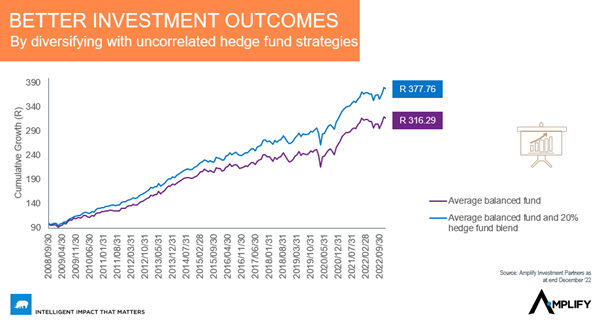By: Emma Pretorius, Business Development Manager: Amplify Investment Partners
With the 2022 FIFA World Cup still fresh in our memory, it is hard to forget the pure elation we felt when witnessing the heroic goals scored by the likes of Messi and Mbappe. Those moments stir up emotions. However, the evidence is fairly conclusive that World Cups don’t tend to be won by the tournament’s most potent and prolific sides, but rather that clean sheets are the key to World Cup glory. Saving one’s side from a sure goal has just as much value as scoring one. In rugby, the Springboks have taken home many trophies through their valiant defensive efforts. It’s much the same in investing – it’s not only about what you make, but also about what you keep.
Traditional long only equity funds are generally measured by their ability to outperform an index. These are your star players – the Messi’s of the world. Then you have your income funds, which make up a formidable back line. But have you ever considered whether your defence may be missing an integral player? Hedge funds are often overlooked by investors when looking to mitigate risk in their portfolio, but many hedge fund strategies could play a crucial role in helping to protect your client’s portfolio against large pendulum-like swings. Why is this important? Because portfolio volatility eats away at compounded returns since large losses reduce your capital base, and you have to make more than you lost just to get back to your original capital level.
Hedge funds that are best suited to mitigating portfolio risk are those with unique investment strategies that have very little relation to equity or other indices. Strategies with low correlation to these indices will offer the greatest diversification benefit to your portfolio, since they move in a unique way relative to other asset classes and serve as an excellent hedge to your portfolio during periods of market turbulence.
While there are numerous hedge fund strategies that can serve as risk diversifiers to your portfolio, within the equity space, investors should look for market-neutral strategies or alternatively, more conservative long short equity strategies which aim to hedge out a great deal of market risk, while still leaving a portion of the portfolio unhedged – allowing investors to participate in some upside while also offering significant downside protection. Fixed income hedge fund strategies are also very well suited for this purpose, since many have very low correlation to either bond or equity indices and have proven their ability to protect and to grow capital during equity bear markets.
The benefits of adding uncorrelated strategies to your portfolio are that it lowers your overall portfolio volatility, significantly reduces portfolio drawdowns, enhances compounded returns, and enables investors to take more risk overall. I.e., with a better supported back line, your star equity managers have more opportunity to create magic.
To illustrate the benefits of adding uncorrelated hedge fund strategies to a traditional long only portfolio, consider an example of a blended hedge fund portfolio consisting of Amplify’s four fixed income hedge fund strategies as well as the Amplify market neutral fund, equally weighted, allocating to each fund at their respective inception dates. This blended hedge fund portfolio is compared to the performance and risk metrics of a portfolio allocating 100% to the ASISA SA MA high equity category versus a portfolio allocating 80% to the ASISA SA MA high equity category and 20% to the hedge fund blended portfolio. The results show that by only allocating 20% of your portfolio to hedge funds, you have managed to increase your return, reduce both the volatility and maximum drawdown of your portfolio materially, and improve the portfolio Sharpe ratio.
Table 1: Benefits of adding uncorrelated hedge fund strategies
| Average balanced fund | Hedge fund blend | Average balanced fund & 20% hedge fund blend | |
| Return | 8,52 | 15,02 | 9,78 |
| Standard Deviation | 7,90 | 4,97 | 6,69 |
| Sharpe Ratio | 0,27 | 1,62 | 0,49 |
| Max Drawdown | -14,12 | -3,61 | -11,87 |
Figure 1: Improved compounded return

By reducing portfolio volatility and mitigating large portfolio drawdowns, you need to work significantly less than the investor whose portfolio suffers large losses and consequently has to work exponentially harder to simply break even. To put it concisely, you are winning by not losing.
*SCI – Sanlam Collective Investments











